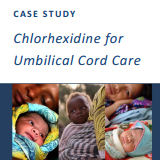
Globally, neonatal infections are estimated to account for over 1 million newborn deaths annually (over a third of the total burden). In many regions, infection is the leading cause of neonatal mortality, and in high?mortality regions infections are responsible for around half of all newborn deaths. Many of these infections come from contamination of the umbilical cord stump. Chlorhexidine digluconate is a widely used, low?cost antiseptic effective against major agents of neonatal infection. Since its introduction in the 1950s, it has been used regularly as a surgical and detail antiseptic and carefully studied for safety and efficacy. Recent community?level randomized controlled trials in Nepal, Pakistan, and Bangladesh have shown that applying a 4% chlorhexidine product (7.1% chlorhexidine digluconate) to the umbilical cord saves lives (the Pakistan and Bangladesh findings were published in The Lancet on February 8, 2012). Across the three countries, data from over 54,000 newborns showed an aggregate 23% reduction in neonatal mortality (not including deaths in the first few hours of life) and a 68% reduction in severe infections for the chlorhexidine intervention groups. These are some of the largest effect sizes seen in any neonatal intervention.
There are literally dozens of manufacturers currently making chlorhexidine?based products around the world, at concentrations from <1% to 20%. Chlorhexidine digluconate—used to make a variety of chlorhexidine finished products—is readily available on every inhabited continent at low cost. The finished product for care of the umbilical cord stump (4% free chlorhexidine, or 7.1% chlorhexidine digluconate) can cost less than US$0.01 in raw materials per baby. It has a long shelf life, requires no cold chain, and is extremely easy to apply with minimal training and no equipment.
These factors make it suitable for hospital, health center, and home care alike. Few other interventions have demonstrated such potential for rapidly reducing newborn mortality across so many settings for such a low cost.
While there have been efforts to improve umbilical cord hygiene by advocating “dry cord care,” these efforts have not always had the intended effect in all settings. Millions of mothers around the world continue to have a strong desire to apply something to the umbilical cord stump of their newborns. In the absence of a specifically recommended product, they resort to a variety of traditional and non?traditional substances including edible oils, ash, dirt, and feces. Where consumer research has been conducted, mothers have shown a strong latent demand for a purpose?made antiseptic like chlorhexidine and also have demonstrated the ability to use chlorhexidine correctly.
Nepal is the first country to have registered a chlorhexidine product specifically for umbilical cord stump care. Additionally, Nepal has included chlorhexidine in their 2011 national list of essential medicines. One of the largest pharmaceutical producers in the country manufactures it for newborn care programs. The government of Nepal has plans to allocate funds in the coming year for procuring the product for broader use.